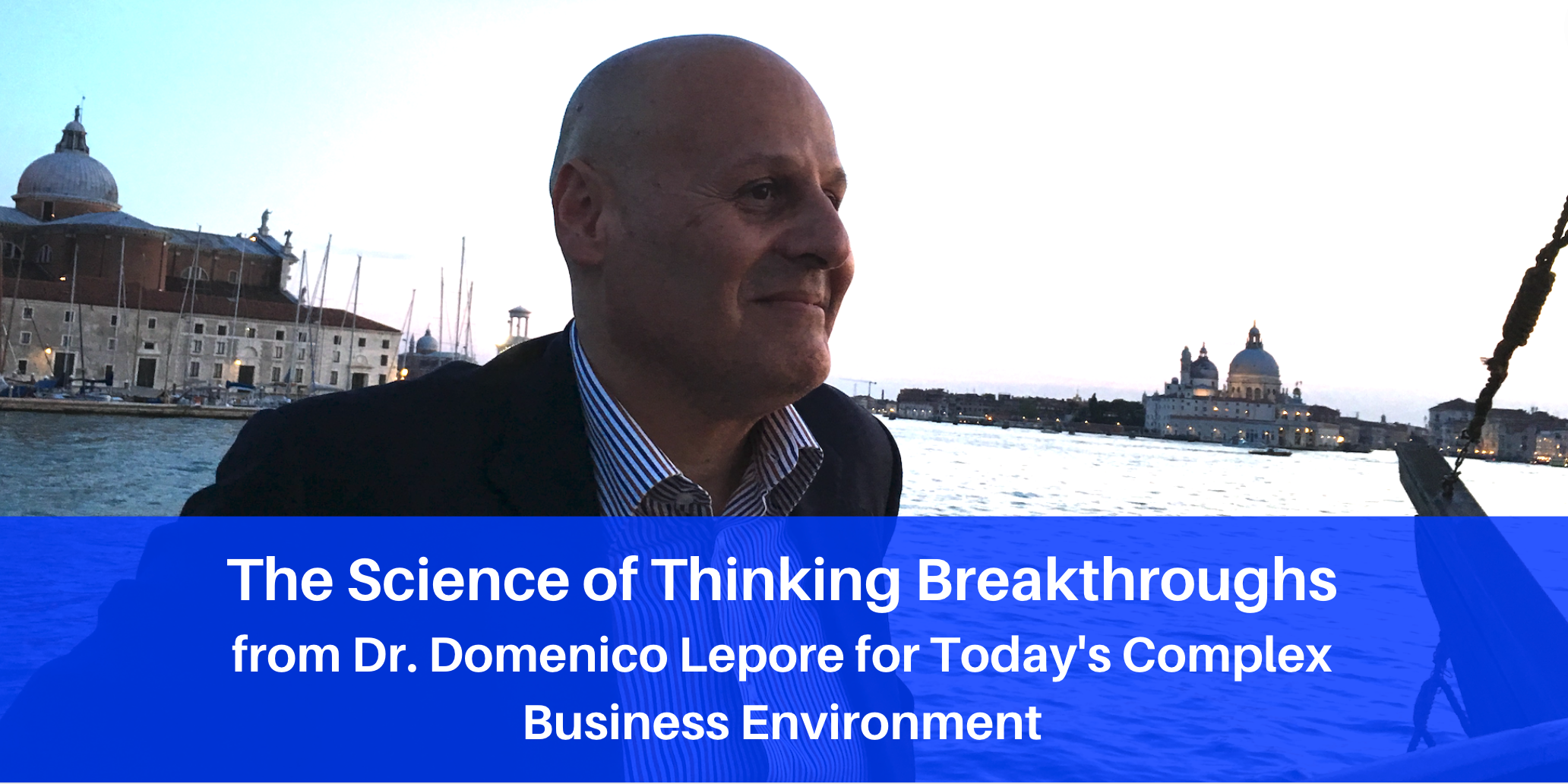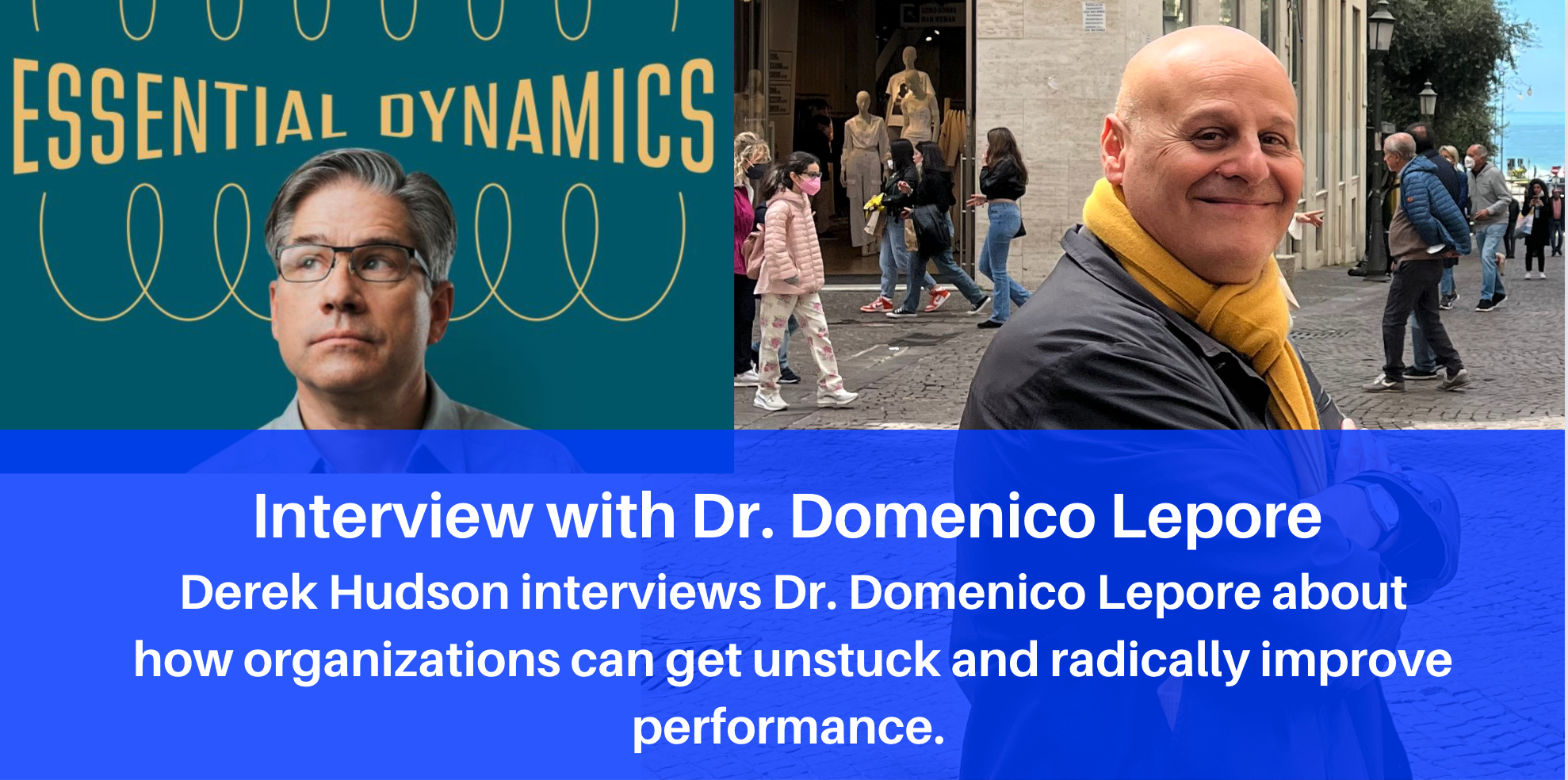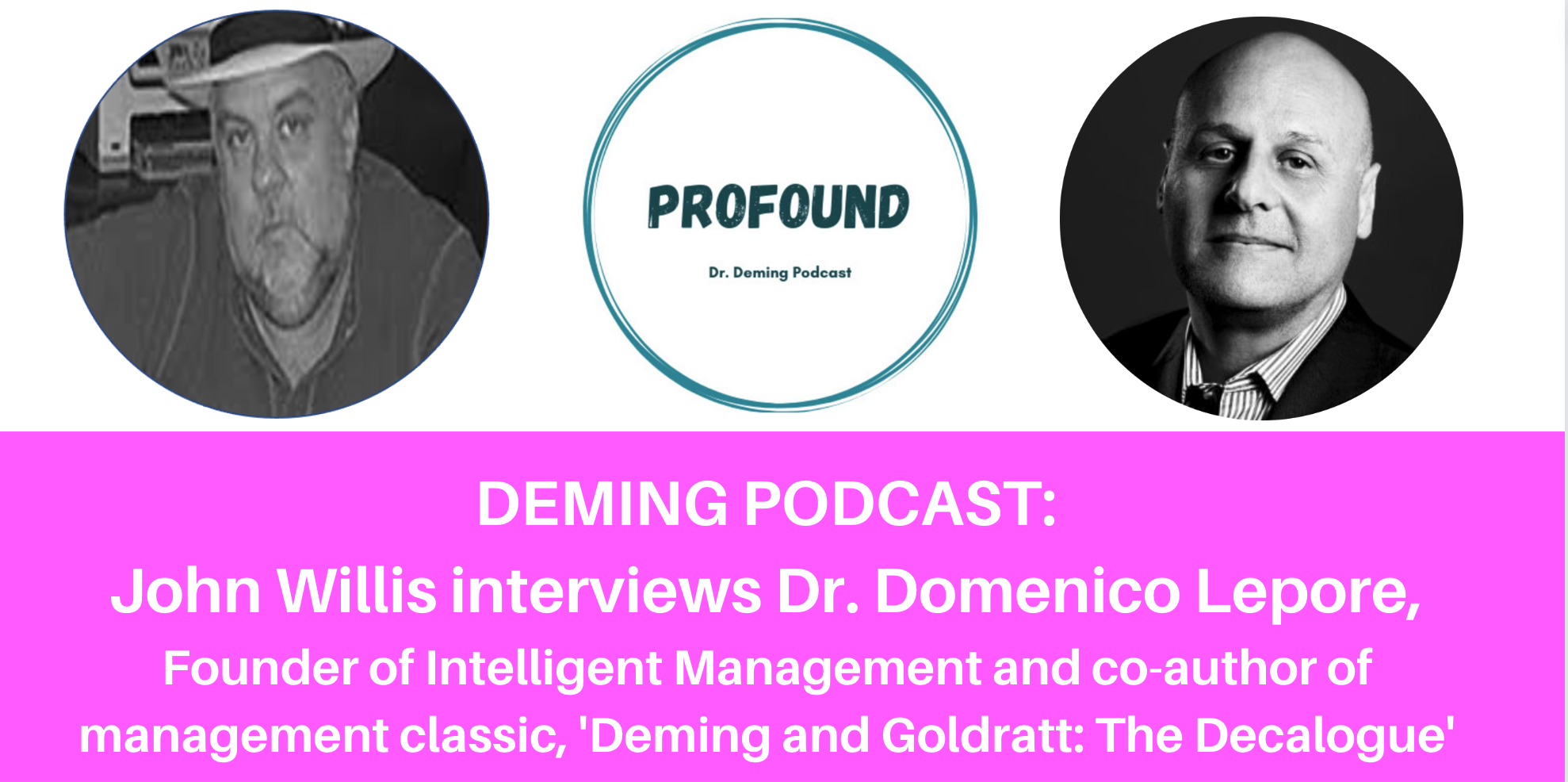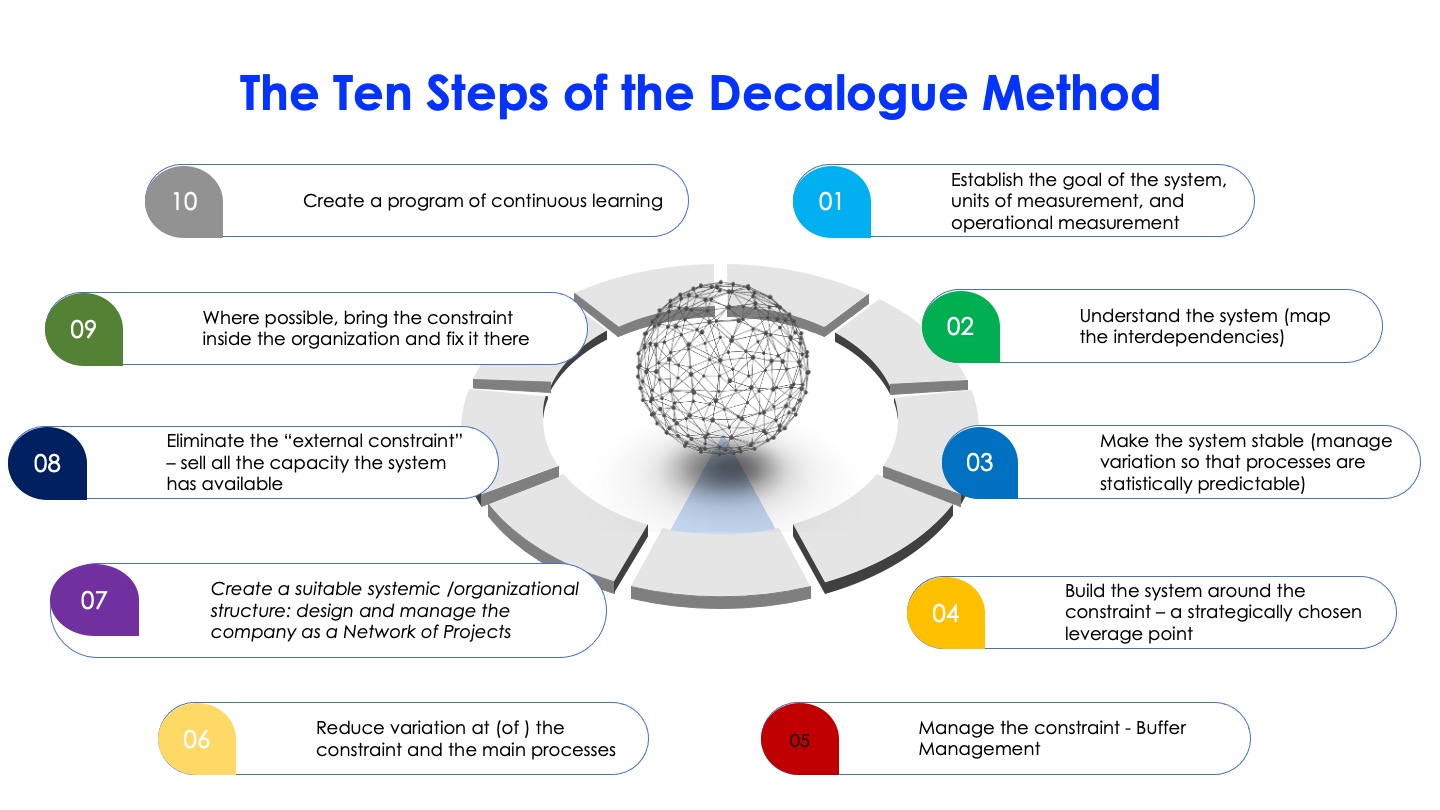
And now for something completely different…
Do you want to hear insight and foresight about business like you’ve never heard before? Dr. Domenico Lepore is one of the most provocative, knowledgeable and impactful business thinkers today. (And yes, he’s our Founder!)
Today’s post is a quick break from our series on a systemic approach to org design, management and operations.
This week, part one of a two-part interview with Domenico went live. (Part two goes live next month.) Thanks to Derek Hudson‘s interview, you can hear Domenico providing a hard-to-find level of clarity on what businesses can do to create breakthrough solutions and thrive in complexity. So it’s a good opportunity to put together several interviews with Domenico on one page.
Getting organizations unstuck
Organizations get stuck but there is a very precise method they can follow to get unstuck and create breakthrough solutions. Dr. Domenico Lepore is interviewed by Derek Hudson about this and much more. Click here to listen to the podcast: https://share.transistor.fm/s/7e66e59c

Quotes from this podcast:
People build their own cognitive prison out of language… the first and foremost reason for people getting stuck is because they get trapped in linguistic and cognitive loops that they cannot escape from.
Cause and effect is not a linear thing. The network of cause and effect relationship creates a field of forces and this field of forces is what determines the way we perceive what we think is reality. So learning how to think cause and effect is exactly the opposite of falling prey of the natural tendency that humans have to see linearity where linearity doesn’t exist.
The Thinking Processes of TOC (Theory of Constraints) are just a gigantic, monumental linguistic framework to allow people to garner the strength of their emotions and channel them in a way they can be used.
You need to embrace a way of thinking where you can connect all your emotions in a way, linguistically, that paves the way for you to generate a breakthrough solution, which frankly is something that can be done on a regular basis.
First, identify… the core conflict of an organization, surface the prevailing mental models that keep us stuck and then develop conceptual solutions which later can become operational plans.
On the shoulders of giants: Deming and Goldratt
Dr. Deming’s work is at the heart of everything Intelligent Management does together with a highly advanced way of using the Theory of Constraints. Dr. Domenico Lepore is interviewed about Deming and Goldratt in John Willis’s podcast. Click here to listen: https://profound.buzzsprout.com/1758599/10121886-profound-dr-deming-s2-e8-domenico-lepore-deming-and-goldratt

Quotes from this podcast:
Deming was a scientist that saw, you know, the need for eliminating barriers, the need for driving our fear. And these needs stemmed from a statistical understanding of the world. So you don’t want to eliminate fear in the workplace because you’re a good man. Or you want to keep it because you’re a bad man. You want to eliminate fear, because fear increases variation in the way you execute your process. We want to eliminate barriers among staff and people, not because you want everybody to love each other that yes, you do, but you want it because that increases variation. So the whole lens of understanding variation within a systemic context was the thing that drew my attention, and enabled me to continue my path of deeper and deeper understanding Dr. Deming, and how to bring Dr. Demmings work to fruition in as many situations as possible.
In spite of all the research that has been done in the last 30 years, about the non linearity of our thinking, you look at Wall Street and how they do it, they think linearly, you think of how people make investments, they do it linearly, you think about how people evaluate their human capital, they do it linearly. And because by fragmenting and putting in silos, things and looking at them individually, and thinking of them linearly, our mind can make sense of it. When you move on to a more complex realm, that becomes a lot more complicated. And people don’t want to take that challenge. It’s like flying visual and flying with with instrumentation. So when you fly visual, you only have to do it just to rely on your senses, and enjoy and enjoy the ride. When you fly at night, you can’t rely on that, you have to rely on on the on the instruments, and and embracing them, it means to fly instrumental. And the instruments are essentially very abstract mathematical concepts. They need to be understood and morphed into a coherent practice.
To absorb, accumulate and develop new knowledge, in order to do that, you have to leverage faculties that partially have to do with your rational side. But most importantly, with your more emotional side. Our intellectual faculties, only three of them are rational, the ability to have intuition, the ability to develop an analysis and the ability to deploy knowledge, but everything else has got to do with how you harness the power of your emotions.
The conflict cloud from TOC (Theory of Constraints) is a way on a superficial level to solve a dispute but in reality it’s to dig deeper in the most fundamental assumptions you make about reality. And in going through that pattern, you alter the way you perceive the world and the way you are in the world. And in that sense, it can be scary, because it moves you constantly beyond your cognitive horizon.
Project Management is broken – Domenico Lepore talks about a powerful way to manage projects systemically
But there is a highly effective, systemic method to manage projects so they complete on time and within budget.
Talking about Project Management in a way you never heard before – here is Dr. Lepore unleashed as he is interviewed by PMI Southern Maryland. You can watch the interview with Domenico below from MINUTE 15 ONWARDS.
Quotes from this video:
The traditional critical path method is plagued by wrong-thinking and wrong habits, such as multitasking and student syndrome, putting off tasks until the last minute, that can slow projects down artificially.
A “realistic” way to manage a project, one that can anticipate its outcome in terms of specs, timeline, and budget, must take into account the finiteness of resources. For this reason, Dr. Goldratt described this arrangement of resources on a timeline as “finite capacity scheduling” and called it Critical Chain, to distinguish it from the more popular (and misleading) Critical Path.
The Critical Chain algorithm for managing projects establishes a buffer at the end of the Critical Chain, the “Constraint” of the project. This project buffer will contract or expand based on its consumption.
Using SPC to monitor the consumption of Project Buffers is an innovation of the Decalogue methodology and provides a more scientifically rigorous and insightful way to manage the overall project than dividing the project buffer into zones.
What my colleagues and I began to see, with greater and greater clarity, starting from the early 2000s, is that the Critical Chain algorithm can be the harbinger for a new organizational design.
If an organization is, essentially, an ongoing collection of unfolding projects, then the focus of leadership, Board, C-Suite, etc., must be on how well and timely these projects are executed.
If an organization is running in parallel a multitude of projects, the more it can deploy suitable competencies, the more it has a chance to complete these projects successfully.
We can simply facilitate teamwork by removing the barriers that prevent it; we can do so by orchestrating people’s talents and skills in a time-sensitive and continuously evolving Network of Projects, bearing in mind the overall goal of the organization. That’s why we developed our software called Ess3ntial.
Ready for a completely new way to build, manage and scale your organization for sustainable growth?
Organizations can achieve so much more when they are managed systemically and competencies are synchronized. Dr. Domenico Lepore presents a whole way new of thinking about organizations and managing operations to drastically improve performance.
Quotes from this video:
The prevailing, silo-based organizations prevent value from being realized. A new organization design must be based on maximizing the three key elements of value generation: Quality, Involvement and Flow.
Digital transformation requires organizations to be networks of value creation.
How can we accelerate people’s involvement? Create correct interdependencies; overcome conflicts; anticipate negative implications; provide effective operational definitions.
We can accelerate Flow through a leverage point in the network where value is most generated. We call it a constraint.
How do we unlock the potential of everyone on the organization? Identify the competencies required for projects, schedule the competencies through Critical Chain, create a network of critically-chained projects.
PREVIOUS POSTS IN OUR SERIES ABOUT A SYSTEMIC APPROACH TO ORG DESIGN, MANAGEMENT AND OPERATIONS:
Radically Improving Organizational Performance – A Systemic Approach to Management Part 1
Leadership for Complex Times – A Systemic Approach to Management Part 5
Working with Variation to Support Good Decision Making – A Systemic Approach Part 7
Why Your Organization’s Constraints Are the Key to Success – A Systemic Approach Part 8
Improving Flow Company Wide – A Systemic Approach Part 9
Controlling the Whole Organization through the Constraint – A Systemic Approach Part 10
End Silos and Dissatisfaction: Learn to Operate as a Network of Projects Organization – A Systemic Approach Part 12
Company Functions Are Limiting Your Organization’s Performance – A Systemic Approach Part 13
Are Companies with a Hierarchical/Functional Mindset Dinosaurs? A Systemic Approach Part 14







Leave a Reply